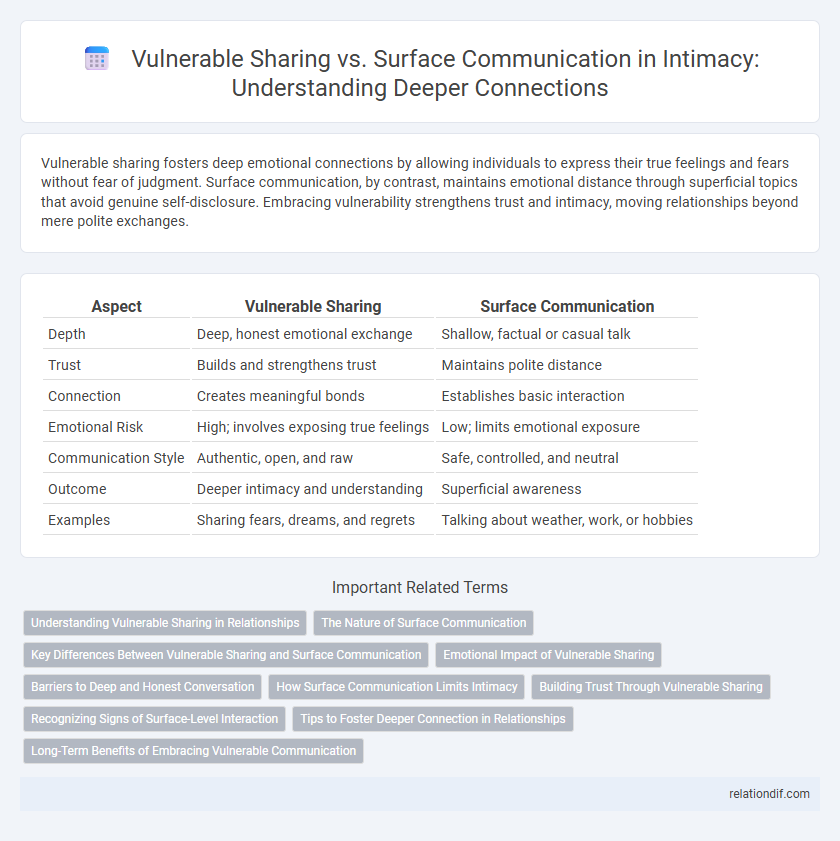Vulnerable sharing fosters deep emotional connections by allowing individuals to express their true feelings and fears without fear of judgment. Surface communication, by contrast, maintains emotional distance through superficial topics that avoid genuine self-disclosure. Embracing vulnerability strengthens trust and intimacy, moving relationships beyond mere polite exchanges.
Table of Comparison
| Aspect | Vulnerable Sharing | Surface Communication |
|---|---|---|
| Depth | Deep, honest emotional exchange | Shallow, factual or casual talk |
| Trust | Builds and strengthens trust | Maintains polite distance |
| Connection | Creates meaningful bonds | Establishes basic interaction |
| Emotional Risk | High; involves exposing true feelings | Low; limits emotional exposure |
| Communication Style | Authentic, open, and raw | Safe, controlled, and neutral |
| Outcome | Deeper intimacy and understanding | Superficial awareness |
| Examples | Sharing fears, dreams, and regrets | Talking about weather, work, or hobbies |
Understanding Vulnerable Sharing in Relationships
Vulnerable sharing in relationships involves expressing true emotions and fears, creating a deeper emotional connection and trust between partners. Unlike surface communication, which often revolves around everyday topics and avoids emotional depth, vulnerable sharing fosters empathy and mutual understanding. This authentic exchange strengthens intimacy by allowing both individuals to feel seen, heard, and accepted on a profound level.
The Nature of Surface Communication
Surface communication involves exchanging casual, non-personal information that avoids emotional depth or vulnerability. This form of interaction often centers on daily routines or general observations, maintaining a safe distance to prevent revealing true feelings or personal struggles. While it facilitates social bonding, it lacks the intimacy and trust built through vulnerable sharing that fosters deeper emotional connections.
Key Differences Between Vulnerable Sharing and Surface Communication
Vulnerable sharing involves open, honest expression of true feelings and fears, fostering deep emotional connection and trust, while surface communication remains limited to superficial topics and avoids personal disclosure. Key differences include emotional depth, with vulnerable sharing exposing inner experiences and surface communication maintaining emotional distance. Vulnerable sharing promotes intimacy and understanding, whereas surface communication often results in relational disconnect and misunderstanding.
Emotional Impact of Vulnerable Sharing
Vulnerable sharing deepens emotional connections by fostering trust and authenticity, allowing individuals to experience empathy and support at a profound level. This openness contrasts with surface communication, which often maintains distance and limits the emotional resonance between participants. The emotional impact of such vulnerability includes reduced feelings of isolation, increased psychological safety, and a stronger foundation for meaningful relationships.
Barriers to Deep and Honest Conversation
Barriers to deep and honest conversation often stem from fear of vulnerability and judgment, which leads individuals to favor surface communication as a protective mechanism. Emotional defenses and past traumas create walls that inhibit genuine sharing, limiting intimacy development. Overcoming these obstacles requires cultivating trust and creating safe spaces where vulnerability is met with empathy rather than criticism.
How Surface Communication Limits Intimacy
Surface communication restricts emotional connection by focusing on superficial topics, preventing deeper understanding and trust between individuals. This avoidance of vulnerability leads to misunderstandings and emotional distance, limiting the growth of genuine intimacy. Genuine intimacy requires openness and honesty, which surface interactions rarely facilitate.
Building Trust Through Vulnerable Sharing
Building trust through vulnerable sharing requires embracing openness and authenticity, allowing deeper emotional connections to form beyond surface communication. Expressing fears, hopes, and imperfections invites empathy and mutual understanding, which solidifies the foundation of intimacy. This depth fosters a safe environment where individuals feel valued and truly heard, enhancing relational resilience.
Recognizing Signs of Surface-Level Interaction
Surface-level interactions often lack emotional depth, characterized by generic topics and avoidance of personal feelings, signaling a reluctance to engage vulnerably. Recognizing signs such as frequent small talk, minimal eye contact, and evasive responses helps identify when communication remains superficial. Developing awareness of these patterns is essential for fostering genuine intimacy through meaningful, authentic dialogue.
Tips to Foster Deeper Connection in Relationships
Sharing emotions with honesty and openness creates a foundation for vulnerability, encouraging deeper intimacy beyond surface communication. Active listening, empathy, and asking meaningful questions help partners feel truly understood and valued. Establishing regular moments for authentic check-ins promotes trust and strengthens emotional bonds in relationships.
Long-Term Benefits of Embracing Vulnerable Communication
Embracing vulnerable communication fosters deeper emotional connections and builds trust over time, essential for long-lasting intimacy. Sharing authentic feelings and fears allows partners to understand each other beyond superficial interactions, promoting resilience in the relationship. This openness reduces misunderstandings and strengthens commitment, creating a secure foundation that benefits couples in the long term.
vulnerable sharing vs surface communication Infographic

 relationdif.com
relationdif.com